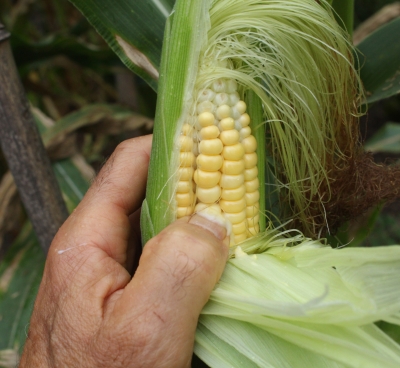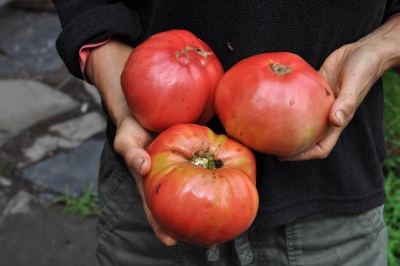Mmmmmmmm
Genetics, Timely Harvest, and ?
As I led my nephew Jeff, his wife, and their two kids around the garden a couple of days ago, I plucked fruits and vegetables here and there for them to sample. They could compare them with what New York City, where they live, has to offer. They were blown away by the flavors here.

Okay, I cheated a little. They got to sample some of the best of the best: figs so soft they were drooping from their stems, white alpine strawberries, Sungold cherry tomatoes, Golden Bantam sweet corn, and Kentucky Wonder green beans, all picked on the spot and at their peak of perfection. The Golden Bantam corn, you won’t find that offered for sale pretty much anywhere these days although it was the standard of excellence in sweet corn 100 years ago. The white alpine strawberries (Pineapple Crush) are too small and too soft for anyone to market commercially.
But genetics isn’t the whole story. Timely harvest is as important. Commercial considerations aside, it takes a certain skill to know just the right moment to do the deed.
With some plants, especially vegetables, timely harvest is easy. You pick such vegetables as lettuce, beans, and okra as soon as they’re big enough to suit you. You pick tomatoes when they’re red, which is also when I pick sweet peppers; red peppers taste quite different and, to me, a lot better than green peppers.
I haven’t grown eggplants that much over the years. This year they are particularly abundant and I’m still learning how to pick them. Full size? Glossy?
Sweet corn can also be tricky. It took me a few years to get the knack of picking it at its best. I first look for dried up silks and then, taking a tip the vegetable extension specialist at the University of Wisconsin passed on to me many years ago, I wrap my fingers around the ear and feel for fullness. That’s when it’s time to snap the ear down and off the stalk. Gauging that fulness does take practice.
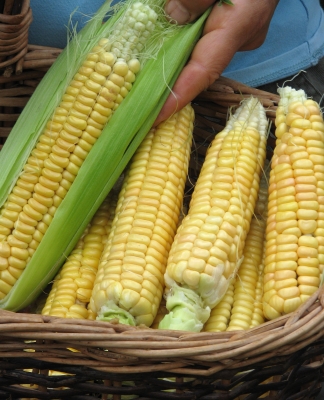
Test for Ripeness
Fruits are a little trickier than vegetables, especially some fruits. Easiest of all are raspberries and blackberries. Tickle the clusters and let the truly ripe ones drop off, as they are wont to do, into the palm of your hand. Too many people tug at blackberries to get them off the plants; flavor suffers. Blueberries are similar to blackberries in that color doesn’t tell of full ripeness; the tickling method does.
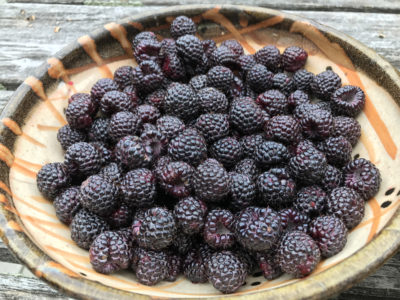
I grow a number of varieties of two vining fruits: grapes, of course, and hardy kiwifruits. The kiwifruits, which will begin ripening in a couple of weeks, retain their fresh, green color right through ripeness. What they do do when ripe is to soften. But not all together. Fortunately, when sufficiently mature on the plant, these fruits can finish ripening after harvest. As soon as the first kiwis ripen, I pick them all. They ripen to perfection in a few days at room temperature, longer under refrigeration.
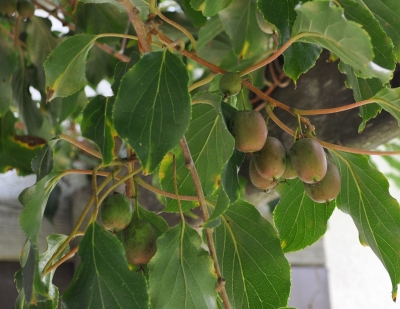
Blue or red grapes seem ripe when they turn their final color. Ripe for commercial purposes perhaps, but not perfectly so. When truly ripe the whole bunch will snap easily from the cane to which it is attached. I sometimes leave the bunches (the ones I enclosed in paper bags in early summer) even longer and, to a point, their flavor just gets better and better.
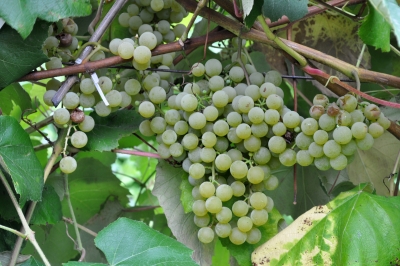
Most fruits, in fact, taste best if harvested when ready to part with the plant. That’s why for fresh eating, not storage, I sometimes harvest my apples from the ground, daily, the morning they drop. This might not be the best method for all varieties but makes for the very best Macoun apples.
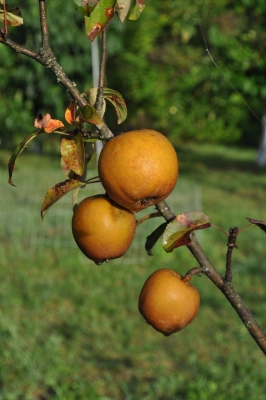
Generally, with tree fruits, I look for a change in color, especially background color, before considering harvesting a fruit. If there’s any green, I let it be. If color tells me that a fruit is potentially ready to be picked, I cup the fruit in hand, then lift and twist. If ripe, the fruit stalk readily separates from the plant. If that doesn’t happen, the fruit needs more time on the plant.
Tricky, for Me at Least
Two fruits whose harvest moment I’m still honing are watermelon and European pears.
I’ve tried all the methods with watermelon: thumping for a sound not too hollow and not to dull (the sound of knocking your knuckles against your chest as opposed to your forehead or stomach); a dried tendril opposite the fruit; a yellow-bellied fruit. They’re all guides but none are the end-all to timely harvest. I never had that problem with my large watermelon crop from my garden in southern Delaware.

Magness pear
European pears ripen from the inside out so become mush if left on the plant to thoroughly ripen. They need to be harvested mature but not yet ripe as indicated by some fruits dropping, a slight change in skin color, and readiness of the fruit stem to part from the branch. Fruits brought indoors to finish ripening are ready to eat when the flesh at the stem end gives with slight finger pressure.
Still, it takes a certain je ne sais quoi. And again, I’m adept at timely harvest of those varieties I’ve grown the longest and of which I have the most.
Climacterics
One reason pears and kiwifruits can ripen to perfection after harvest is because they are climacteric fruits, which undergo a burst of respiration and ethylene (a plant hormone) production as ripening begins. Some of these fruits, which also which include banana, apple, tomato, and avocado can, if sufficiently mature, ripen following harvest. Soon after their climacteric peak, these fruits start their decline.
Citrus, fig, strawberry, plum, and raspberry are examples of non-climacteric fruits, whose ripening proceeds more calmly. Non-climacteric fruits will not ripen at all after they’ve been harvested. They might soften and sweeten as complex carbohydrates break down into simple sugars, but such changes are indicative of incipient rot rather than ripening or flavor enhancement.
For more about flavor, ripening, and climacteric, see my latest book The Ever Curious Gardener: Using a Little Natural Science for a Much Better Garden.

